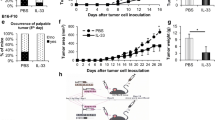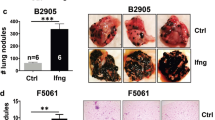Summary
The effect of murine α/β interferon (IFN) on experimental metastasis was investigated using B16-F10 melanoma cells. Since the outcome of metastasis of blood-borne tumor cells is mainly determined within the first 24 h after i.v. inoculation of tumor cells, i.p. injection of IFN was focused on this critical early phase. The inhibition of pulmonary metastases by IFN was found to be maximal when given 3 h prior to tumor cell inoculation, while mice with 24-h and 12-h pretreatment and simultaneous IFN treatment also showed a reduction in metastases, but to a lesser extent. However, mice receiving IFN 2 h after tumor cell inoculation did not show any reduction. Tumor cells cultured for 24 h in IFN-containing medium showed no reduction in metastases. Administration of anti-asialo GMl prior to IFN treatment was found to eliminate the inhibitory effect of IFN 3 h pretreatment. However, natural killer (NK) cell activity in vitro measured at 3 h, 13 h and 24 h after IFN administration was enhanced to the same extent, not paralleling the inhibitory effect on pulmonary metastases. These data indicate that prepared host status against blood-borne tumor cells is established by IFN pretreatment, being maximal when injected several hours prior to tumor cell inoculation, and that this effect is substantially dependent on NK cell activity, though the implication of other factors is not excluded.
Similar content being viewed by others
References
Brouty-Boyé D, Zetter BR (1980) Inhibition of cell motility by interferon. Science 208:516–518
Djeu JY, Heinbaugh JA, Holden HT, Herberman RB (1979) Augmentation of mouse natural killer cell activity by interferon and interferon inducers. J Immunol 122: 175–181
Fidler IJ (1970) Metastasis: Quantitative analysis of distribution and fate of tumor emboli labeled with 125I-5-iodo-2′-deoxyuridine. J Natl Cancer Inst 45:773–782
Fidler IJ (1973) Selection of successive tumor lines for metastasis. Nat New Biol 242:148–149
Fodstad Ø, Hansen CT, Cannon HB, Statham CN, Lichtenstein GR, Boyd MR (1984) Lack of correlation between natural killer activity and tumor growth control in nude mice with different immune defects. Cancer Res 44:4403–4408
Glasgow LA, Kern ER (1981) Effect of interferon administration on pulmonary osteogenic sarcomas in an experimental murine model. J Natl Cancer Inst 67:207–210
Habu S, Fukui H, Shimamura K, Kasai M, Nagai Y, Okumura K, Tamaoki N (1981) In vivo effect of anti-asialo GMl. I. Reduction of NK activity and enhancement of transplanted tumor growth in nude mice. J Immunol 127:34–38
Hanna N (1982) Inhibition of experimental tumor metastasis by selective activation of natural killer cells. Cancer Res 42:1337–1342
Hanna N, Burton RC (1981) Definitive evidence that natural killer (NK) cells inhibit experimental tumor metastasis in vivo. J Immunol 127:1754–1758
Hanna N, Fidler IJ (1980) Role of natural killer cells in the destruction of circulating tumor emboli. J Natl Cancer Inst 65:801–809
Imanishi J, Kita M, Sugino S, Oku T, Kishida T (1982) Elimination of polynucleotide-induced hyporeactivity in mice treated with interferon and antitumor therapy. J Interferon Res 2:65–74
Imokawa G, Mishima Y (1982) Loss of melanogenic properties in tyrosinases induced by glycosylation inhibitors within malignant melanoma cells. Cancer Res 42:1994–2002
Irimura T, Gonzales R, Nicolson GL (1981) Effects of tunicamycin on B16 metastatic melanoma cell surface glycoproteins and blood-borne arrest and survival properties. Cancer Res 41:3411–3418
Lee SH, Chiu H, Rinderknecht W, Sabo W, Stebbing N (1983) Importance of treatment regimen of interferon as an antitumor agent. Cancer Res 43:4172–4175
Matsuyama M (1979) Action of interferon on cell membrane of mouse lymphocytes. Exp Cell Res 124:253–259
Mishima Y, Ueda M, Mojamdar M, Ichihashi M, Kita M, Kishida T (1983) Suppression of melanoma metastasis by interferon. In: Kishida T (ed) Interferons. Proceedings of the International Symposium on Interferons. Japan Convention Services Inc, Osaka, pp 62–67
Pfeffer LM, Wang E, Tamm I (1980) Interferon effects on microfilament organization, cellular fibronectin distribution, and cell motility in human fibroblasts. J Cell Biol 85:9–17
Poste G, Fidler IJ (1980) The pathogenesis of cancer metastasis. Nature (Lond) 283:139–146
Poste G, Nicolson GL (1980) Arrest and metastasis of blood-borne tumor cells are modified by fusion of plasma membrane vesicles from highly metastatic cells. Proc Natl Acad Sci USA 77:399–403
Raz A, Ben-Ze'ev A (1983) Modulation of the metastatic capability in B16 melanoma by cell shape. Science 221:1307–1310
Satomi H, Oku T, Kita M, Imanishi J, Kishida T (1983) Antimetastatic effect of interferon against murine osteogenic sarcoma. In: Kishida T (ed) Interferons. Proceedings of the International Symposium on Interferons. Japan Convention Services Inc, Osaka, pp 57–62
Schultz RM, Chirigos MA, Heine UI (1978) Functional and morphologic characteristics of interferon-treated macrophages. Cell Immunol 35:84–91
Schulz RM, Papamatheakis JD, Chirigos MA (1977) Interferon: An inducer of macrophage activation by polyanions. Science 197:674–676
Volk T, Geiger B, Raz A (1984) Motility and adhesive properties of high- and low-metastatic murine neoplastic cells. Cancer Res 44:811–824
Author information
Authors and Affiliations
Rights and permissions
About this article
Cite this article
Ueda, M., Mishima, Y., Mojamdar, M. et al. Time-dependent suppression of melanoma metastases and natural killer cell activation by interferon. Arch Dermatol Res 278, 329–334 (1986). https://doi.org/10.1007/BF00407748
Received:
Issue Date:
DOI: https://doi.org/10.1007/BF00407748




